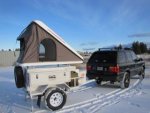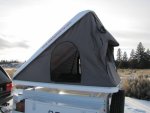http://www.cascadiatents.com/Roof_Top_Tents.htm?m=94
I don't know whether Cascadia stole AutoHome's designs and intellectual property to make these knock-offs, or if AutoHome's patents have expired on the Maggiolina and Columbus, and Cascadia is legally allowed to copy AutoHome's designs.
I love the idea of a hardshell RTT with an integrated solar panel on the roof, but wish the solar panel was larger than the one on Cascadia's RTT. Having a solar panel permanently mounted on the tent roof can maximize the amount of time that the truck's batteries are charging. But what Cascadia did is kind of asinine. Their Mt. Saint Helens Solar Powered RTT charges a battery inside the tent, which powers electric scissor lifts to automatically open and close the tent instead of manually cranking a handle. What's the point? You can do the same thing with a cordless drill, or better yet, with the gas rams in an Air Top tent. I assume that the battery also powers the light in the tent and can run some 12 volt accessories. There is no mention of the battery's capacity or the wattage of the solar panel. There is also no mention of whether the tent is pre-wired to be able to charge the batteries in the rig if so desired.
The link to the video of the solar powered RTT on Cascadia's webpage is broken, but I found it on Cascadia's YouTube channel. Be warned, the guy from the Cascadia video says: "It may be a little slow. Because I've had it in the shop. It hasn't charged a whole lot, being out of the sun." It takes four minutes to open!!! Of course, he doesn't say how fast it opens and closes with a fully charged battery. Here is a link to the video:
http://www.youtube.com/watch?v=QrtR...DvjVQa1PpcFPFOeDAVyhftLJ3KpdRFpUprnqBoKxvf4k=
Using the door with wings as a mini awning seems like a good way to maximize ventilation while shading the inside of the tent from the sun. However, if it starts raining it looks like the water will pool on top of the door.
There is also another video of the interior of the Maggiolina-style tent at the following link:
http://www.cascadiatents.com/index.php?m=94&s=594&c=&id=118&&mode=27




I don't know whether Cascadia stole AutoHome's designs and intellectual property to make these knock-offs, or if AutoHome's patents have expired on the Maggiolina and Columbus, and Cascadia is legally allowed to copy AutoHome's designs.
I love the idea of a hardshell RTT with an integrated solar panel on the roof, but wish the solar panel was larger than the one on Cascadia's RTT. Having a solar panel permanently mounted on the tent roof can maximize the amount of time that the truck's batteries are charging. But what Cascadia did is kind of asinine. Their Mt. Saint Helens Solar Powered RTT charges a battery inside the tent, which powers electric scissor lifts to automatically open and close the tent instead of manually cranking a handle. What's the point? You can do the same thing with a cordless drill, or better yet, with the gas rams in an Air Top tent. I assume that the battery also powers the light in the tent and can run some 12 volt accessories. There is no mention of the battery's capacity or the wattage of the solar panel. There is also no mention of whether the tent is pre-wired to be able to charge the batteries in the rig if so desired.
The link to the video of the solar powered RTT on Cascadia's webpage is broken, but I found it on Cascadia's YouTube channel. Be warned, the guy from the Cascadia video says: "It may be a little slow. Because I've had it in the shop. It hasn't charged a whole lot, being out of the sun." It takes four minutes to open!!! Of course, he doesn't say how fast it opens and closes with a fully charged battery. Here is a link to the video:
http://www.youtube.com/watch?v=QrtR...DvjVQa1PpcFPFOeDAVyhftLJ3KpdRFpUprnqBoKxvf4k=
Using the door with wings as a mini awning seems like a good way to maximize ventilation while shading the inside of the tent from the sun. However, if it starts raining it looks like the water will pool on top of the door.
There is also another video of the interior of the Maggiolina-style tent at the following link:
http://www.cascadiatents.com/index.php?m=94&s=594&c=&id=118&&mode=27




Last edited:
